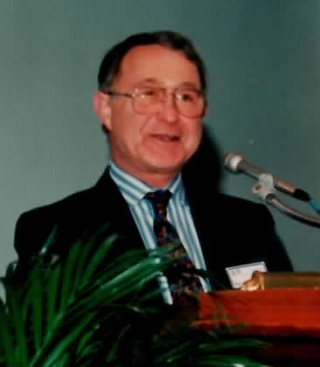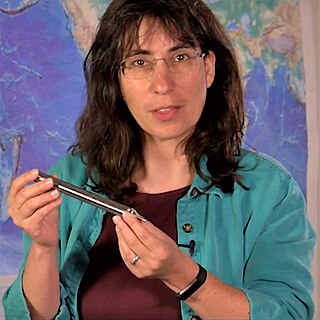Related Research Articles

William Maurice "Doc" Ewing was an American geophysicist and oceanographer.
Dale Lester Boger is an American medicinal and organic chemist and former chair of the Department of Chemistry at The Scripps Research Institute in La Jolla, CA.
Graham Andrew Colditz MD, DrPH is an Australian chronic disease epidemiologist. He is the inaugural Niess-Gain Professor at Washington University School of Medicine, where he is associate director for Prevention and Control at the Alvin J. Siteman Cancer Center. He directs the Master of Population Health Science at Washington University School of Medicine. During medical training he was excited by the potential for prevention of chronic diseases. With encouragement from mentors he pursued training in the US as it was routine for academics in Australia to obtain overseas training at that time. He is internationally recognized for leadership in cancer prevention, and is often interviewed by media for input on this topic. With members of Cancer Prevention and Control at Siteman, he blogs on issues relating to cancer prevention and screening. According to Google Scholar statistics, Colditz has a h-index of more than 300.

Sean Carl Solomon is the director of the Lamont–Doherty Earth Observatory of Columbia University, where he is also the William B. Ransford Professor of Earth and Planetary Science. Before moving to Columbia in 2012, he was the director of the Department of Terrestrial Magnetism at the Carnegie Institution in Washington, D.C. His research area is in geophysics, including the fields of planetary geology, seismology, marine geophysics, and geodynamics. Solomon is the principal investigator on the NASA MESSENGER mission to Mercury. He is also a team member on the Gravity Recovery and Interior Laboratory mission and the Plume-Lithosphere Undersea Melt Experiment (PLUME).

James Freeman Gilbert was an American geophysicist, best known for his work with George E. Backus on inverting geophysical data, and also for his role in establishing an international network of long-period seismometers.

Phil S. Baran is a Professor in the Department of Chemistry at the Scripps Research Institute and Member of the Skaggs Institute for Chemical Biology. Baran has authored over 130 published scientific articles. He has several patents. His work is focused on synthesizing complex organic compounds, the development of new reactions, and the development of new reagents.

Judith P. Klinman is an American chemist, biochemist, and molecular biologist known for her work on enzyme catalysis. She became the first female professor in the physical sciences at the University of California, Berkeley in 1978, where she is now Professor of the Graduate School and Chancellor's Professor. In 2012, she was awarded the National Medal of Science by President Barack Obama. She is a member of the National Academy of Sciences, American Academy of Arts and Sciences, American Association for the Advancement of Science, and the American Philosophical Society.

Diane McKnight is a distinguished professor of civil, environmental, and architectural engineering at the University of Colorado Boulder and a fellow at the Institute of Arctic and Alpine Research (INSTAAR). McKnight is a founding principal investigator of the National Science Foundation's Long-Term Ecological Research (LTER) program in the McMurdo Dry Valleys of Antarctica.
Rohit Pappu is an Indian-born computational and theoretical biophysicist. He is the Gene K. Beare Distinguished Professor of Engineering and the director of the Center for Science & Engineering of Living Systems (CSELS) at Washington University in St. Louis.
Elizabeth J. (Betsy) Beise is a Professor of Physics and Associate Provost at the University of Maryland, College Park. She works on quantum chromodynamics, nucleon structure and fundamental symmetries.
Kimberly A. Prather is an American atmospheric chemist. She is a distinguished chair in atmospheric chemistry and a distinguished professor at the Scripps Institution of Oceanography and department of chemistry and biochemistry at UC San Diego. Her work focuses on how humans are influencing the atmosphere and climate. In 2019, she was elected a member of the National Academy of Engineering for technologies that transformed understanding of aerosols and their impacts on air quality, climate, and human health. In 2020, she was elected as a member of the National Academy of Sciences. She is also an elected Fellow of the American Philosophical Society, American Geophysical Union, the American Association for the Advancement of Science, American Philosophical Society, and the American Academy of Arts and Sciences.
Maureen D. Long is an observational seismologist studying mantle and Mesosphere dynamics. She currently serves as a professor at Yale University within the Department of Geology and Geophysics.

Emily E. Brodsky is a Professor of Earth Sciences at the University of California, Santa Cruz. She studies the fundamental physical properties of earthquakes, as well as the seismology of volcanoes and landslides. In 2023, she was elected to the National Academy of Sciences.
Miaki Ishii is a seismologist and Professor of Earth and Planetary Sciences at Harvard University.
Barbara Mary Hickey is an Emeritus Professor of Oceanography at the University of Washington. Her research involves field measurements and computational models to understand coastal processes. She is a Fellow of the American Geophysical Union.
Frederik J. Simons is a Flemish Belgian geophysicist. He is a professor at Princeton University in the Department of Geosciences. From 2010 to 2013, Simons was the Dusenbury University Preceptor of Geological & Geophysical Sciences. From 2004 to 2006, he was a lecturer in the Department of Earth Sciences at University College London. Between 2002 and 2004 he was a Harry H. Hess Postdoctoral Fellow in the Department of Geosciences and a Beck Fellow with the Council on Science and Technology, also at Princeton University.
Thorne Lay is an American seismologist. He was born in Casper, Wyoming in 1956, and raised in El Paso, Texas. He is a professor of earth and planetary sciences at the University of California, Santa Cruz.
Raymond E. Arvidson is the James S. McDonnell Distinguished Professor of Earth and Planetary Sciences at Washington University in St. Louis. He is known for his contributions to NASA missions to Mars, including as deputy director of the Mars Exploration Rovers.
Seth Avram Stein is an American geophysicist with an international reputation for his research in plate tectonics, seismology, and space geodesy. He has also done important work in public policy for coping with earthquake hazards.
William Roy Young is an Australian-American oceanograoher and a professor at the Scripps Institution of Oceanography at the University of California San Diego.
References
- ↑ "Douglas A. Wiens". wustl.edu. Retrieved April 22, 2017.
- ↑ "Doug Wiens". wustl.edu. Retrieved April 22, 2017.
- ↑ "Physics Tree - Douglas A. Wiens". academictree.org. Retrieved 2021-08-17.
- ↑ "News - Video - Douglas Wiens talks about his project to learn how the Gamburtsev Mountains formed. | NSF - National Science Foundation". www.nsf.gov. Retrieved 2021-08-17.
- ↑ "Douglas Wiens" (PDF). Archived (PDF) from the original on 2020-05-01.
- ↑ https://eeps.wustl.edu/files/eps/Vita_nopubs_2023.pdf
- ↑ https://eeps.wustl.edu/files/eps/Vita_nopubs_2023.pdf
- ↑ https://agupubs.onlinelibrary.wiley.com/doi/pdf/10.1029/2007EO260013
- ↑ https://scripps.ucsd.edu/news/prominent-seismologist-unlocks-antarcticas-secrets-public-lecture
- ↑ https://www.iris.edu/hq/programs/epo/distinguished_lectureship